Descubrí por casualidad que era posible mostrar un cuadro combinado con zenity (versión probada: 2.32.1). Ver el siguiente código:
#!/bin/bash
array=(a b c d e)
value=$(zenity --entry --title "Window title" --text "${array[@]}" --text "Insert your choice.")
El resultado se ilustra con las siguientes 3 imágenes:



Tengo dos preguntas al respecto:
¿Existe alguna documentación sobre esta funcionalidad? No encontré nada en la documentación de zenity .
¿Por qué el primer valor de mi matriz no aparece en el cuadro combinado? En el ejemplo anterior, mi matriz es
(a b c d e)y solo se muestra el cuadro combinadob c d e.Como solución alternativa, agrego un valor en mi matriz, por ejemplo
(0 a b c d e).
